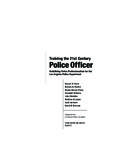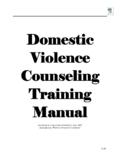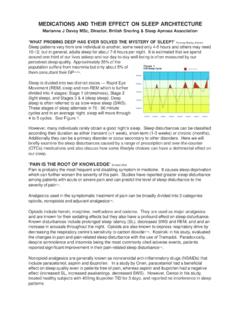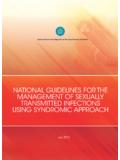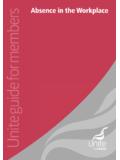Transcription of Borderline Personality Disorder - - RN.org®
1 Borderline Personality Disorder Reviewed May, 2017, Expires May, 2019 Provider Information and Specifics available on our Website Unauthorized Distribution Prohibited 2017 , , , LLC By Wanda Lockwood, RN, BA, MA Purpose The purpose of this course is to define Borderline Personality Disorder , describe the symptoms, causes, treatments, and co-morbid conditions. Goals Upon completion of this course, one should be able to: Differentiate Borderline Personality Disorder from narcissistic, histrionic, and antisocial Personality disorders . Discuss the causes of Borderline Personality Disorder . Describe 8-10 types of symptoms related to Borderline Personality Disorder . Discuss issues related to children and adolescents. List at least 3 co-morbid conditions of Borderline Personality Disorder .
2 Describe at least 4 types of therapy for Borderline Personality Disorder . Introduction With some psychiatric disorders , it s difficult to paint an exact picture of symptoms because they may be so varied within one individual and among different individuals. This is the case with Borderline Personality Disorder , which was originally called Borderline because it was believed that people with this Disorder were on the border of neurosis and psychosis although some researchers believe that this is not a correct description and the Disorder should be renamed. There are so many variations in presentation that people may be misdiagnosed or not diagnosed at all compounding the challenges that people face. People with Borderline Personality Disorder are often difficult for friends and families to cope with because of their profound insecurities, disorganized lifestyles, self-destructive tendencies, and lack of self-awareness.
3 However, people with Borderline Personality Disorder can respond to treatment, so healthcare providers must recognize the patterns of behavior that are typical of Borderline Personality Disorder . What is Borderline Personality Disorder ? Borderline Personality Disorder is a serious dramatic-erratic Personality Disorder , classified by DSM-IV as part of a group of 4 related Personality disorders although symptoms may overlap with the patient with Borderline Personality Disorder showing characteristics of the other types of disorders : Borderline Personality Disorder : The patient may have wide-ranging symptoms, including extreme emotional lability, polarized thinking ( splitting ), unstable relationships, poor self-image, self-destructiveness, and lack of self-identity. Narcissistic Personality Disorder : The patient has a self-centered pattern of grandiosity, deep need for admiration of others, and a lack of empathy for the feelings of others, but is less self-destructive.
4 Histrionic Personality Disorder : The patient has extreme emotional lability and need for attention and is often sexually inappropriate and provocative, but less self-destructive than those with Borderline Personality Disorder . Antisocial Personality Disorder : The patient shows a disregard and lack of empathy for others or the rights of others and has a history of conduct Disorder before age 15. While only about 2% of the general population have Borderline Personality Disorder , these patients represent 10% of psychiatric outpatients, and 20% of psychiatric inpatients. Borderline Personality Disorder is much more common in females (1:33) than males (1:100). What are the causes of Borderline Personality Disorder ? As with most psychiatric disorders , there is probably interplay of genetic, hormonal, brain chemistry, and environmental factors that influence development of the Disorder , and researchers have not been able to define the exact cause.
5 The chance of developing Borderline Personality Disorder is 6 times higher for those with a family history of the Disorder . However, there is a close correlation between a history of childhood abuse (especially sexual abuse such as incest), neglect, and abandonment and Borderline Personality Disorder . While statistics vary, studies show that 20-70% of females with Borderline Personality Disorder report a history of sexual abuse, and the numbers may be higher because of the reluctance of many patients to admit they were victims of sexual abuse or incest. What are the symptom criteria for Borderline Personality Disorder ? While Borderline Personality Disorder is classified as a Personality Disorder , the symptoms include behavioral as well as Personality traits. Borderline Personality Disorder is characterized by poor interpersonal relationships, distortions of selfimage, and marked impulsivity in many areas including 5 of the following criteria: Fear of abandonment: Often there is irrational fear of abandonment if immediate needs not met, such as if someone is delayed or changes plans, related to fear of being alone.
6 Unstable interpersonal relationships: There is vacillation between unrealistic idealizing and vilifying a partner, often with abrupt shifts in opinions. Frequent promiscuous relationship are common as well as an inability to set boundaries in a relationship. The person may utilize splitting and idealize some people and devalue others. There is a strong need for attachment, but behavior is often alienating. Poor self-image/identity disturbance: The person has a disturbed sense of identity resulting in wild swings in self-image related to goals, values, sexuality, friends, and career. There are persistent feelings of being bad, evil, or non-existent. Self-damaging impulsivity (in 2 areas): Excessive spending, gambling, sex, substance abuse, reckless driving, and eating disorders , such as binge eating are common.
7 Suicidal or self-mutilating behavior: The person makes frequent threats or attempts of suicide and self-injurious behavior, such as cutting or burning (occur in 60%), often in reaction to threats of separation, depression, or feelings of abandonment, usually beginning during adolescence or early adulthood. Cutting/burning may relieve feelings of dysphoria. Suicide threats sometimes are used as a method of controlling others. About 8-10% die from successful suicide. About 70-75% commit at least one act of deliberate self-harm. Affective instability: The person has intense periods of dysphoria, anxiety, irritability persisting for hours or a few days, disrupted by episodes of anger, panic, or despair. Feelings of emptiness: The person is chronically depressed, easily bored, and constantly seeking something to fill the emptiness, but often undermining success in school, work, or relationships to ensure repeated failure.
8 Lack of anger control: Temper tantrums, frequent displays of anger, verbal outbursts and sarcasm, constant states of anger, and recurrent physical fights are common. Transient ideation or severe dissociative symptoms: Episodes of dissociation may persist for minutes or hours and occur in relation to stress and feelings of being abandoned by nurturer or caregiver. Sometimes psychotic type hallucinations or hypnagogic phenomena (hallucinations, visions, tactile sensations, or paralysis during the period between being awake and falling asleep) may occur. What exactly is splitting? Splitting is a defense mechanism in which people keep opposing feelings separate in their minds rather than integrating them resulting in extremes with feelings, attitudes, and actions veering wildly from one extreme to the other.
9 For example, a girl who has been sexually abused by her father may see the perpetrator as a kindly loving wonderful father on one hand and a horrible monster on the other. Sometimes she will view him only as loving and idealize him for being a wonderful father. Other times, she will see him only as completely evil. She is not able to integrate these two different pictures, so her feelings and reactions careen back and forth between the two. She may view herself in the same way good girl on one side but evil on the other. There is no diagnostic test for Borderline Personality Disorder , so diagnosis is made on the basis of a psychiatric exam, symptoms related to these criteria, and history. Symptoms usually peak in early adulthood, and this is the time when suicide is the greatest danger. Most people stabilize between their 30s and 40s and are better able to function in relationships and careers.
10 How does Borderline Personality Disorder affect children? Symptoms associated with Personality disorders often manifest during childhood, but there is no consensus related to diagnoses of the pediatric population. Children may exhibit a syndrome characterized by behavioral problems, mood and anxiety disorders , and cognitive impairment. Some researchers describe this syndrome as Borderline because the symptoms often resemble those experienced by adults with Borderline Personality Disorder ; however, the disease progression is not so clear as children may go on to develop a wide range of Personality disorders , sometimes including Borderline Personality Disorder but not always. Children with these symptoms often share the same types of exposure to neglect and physical and sexual abuse, suggesting a similar causal relationship.










